University Accounting Assignment: ACCT20073 - Company Accounting
VerifiedAdded on 2022/10/10
|7
|1186
|400
Homework Assignment
AI Summary
This assignment solution addresses key concepts in company accounting, including fair value measurement according to IFRS 13, historical cost accounting, and impairment testing of cash-generating units (CGUs). The solution analyzes how market participants determine fair value, considering factors like asset condition and restrictions, and compares this to historical cost accounting. The assignment also examines the process of impairment testing, emphasizing the determination of net present value and the impact of cash flow volatility. The solution highlights the importance of independent cash flows and strategic management in assessing CGUs, particularly in the context of route packages for a bus company. The assignment draws upon various sources to support its analysis.
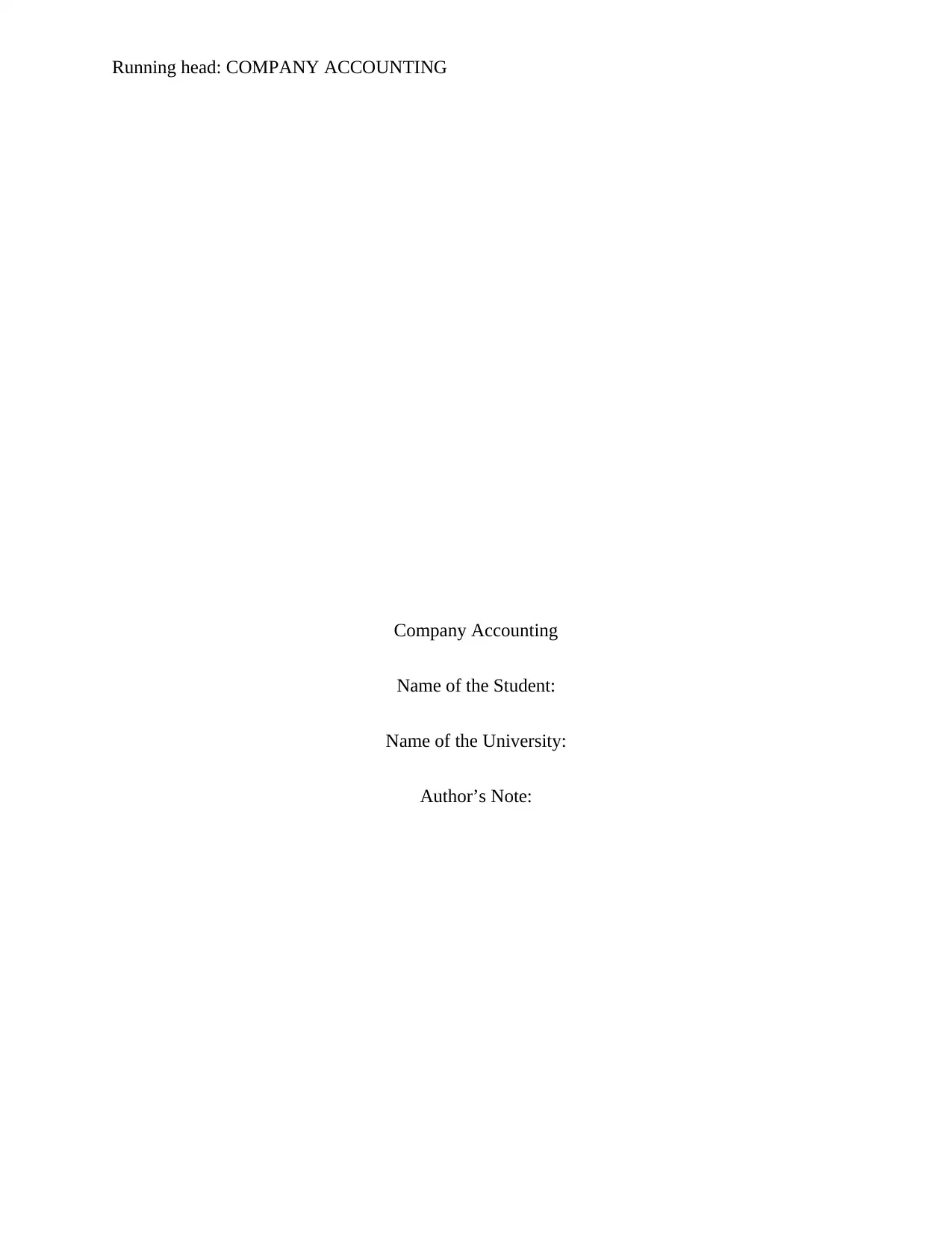
Running head: COMPANY ACCOUNTING
Company Accounting
Name of the Student:
Name of the University:
Author’s Note:
Company Accounting
Name of the Student:
Name of the University:
Author’s Note:
Paraphrase This Document
Need a fresh take? Get an instant paraphrase of this document with our AI Paraphraser
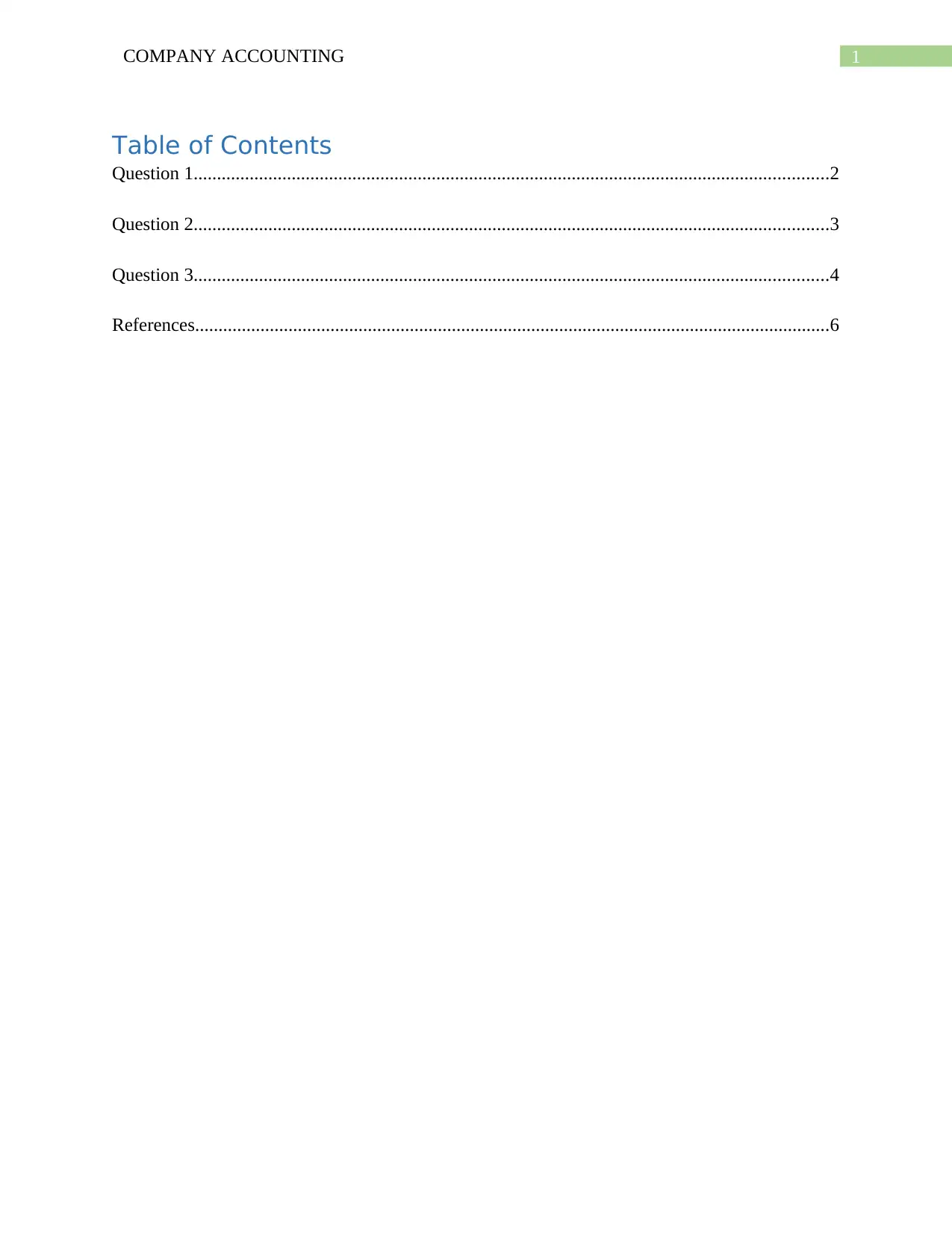
1COMPANY ACCOUNTING
Table of Contents
Question 1........................................................................................................................................2
Question 2........................................................................................................................................3
Question 3........................................................................................................................................4
References........................................................................................................................................6
Table of Contents
Question 1........................................................................................................................................2
Question 2........................................................................................................................................3
Question 3........................................................................................................................................4
References........................................................................................................................................6
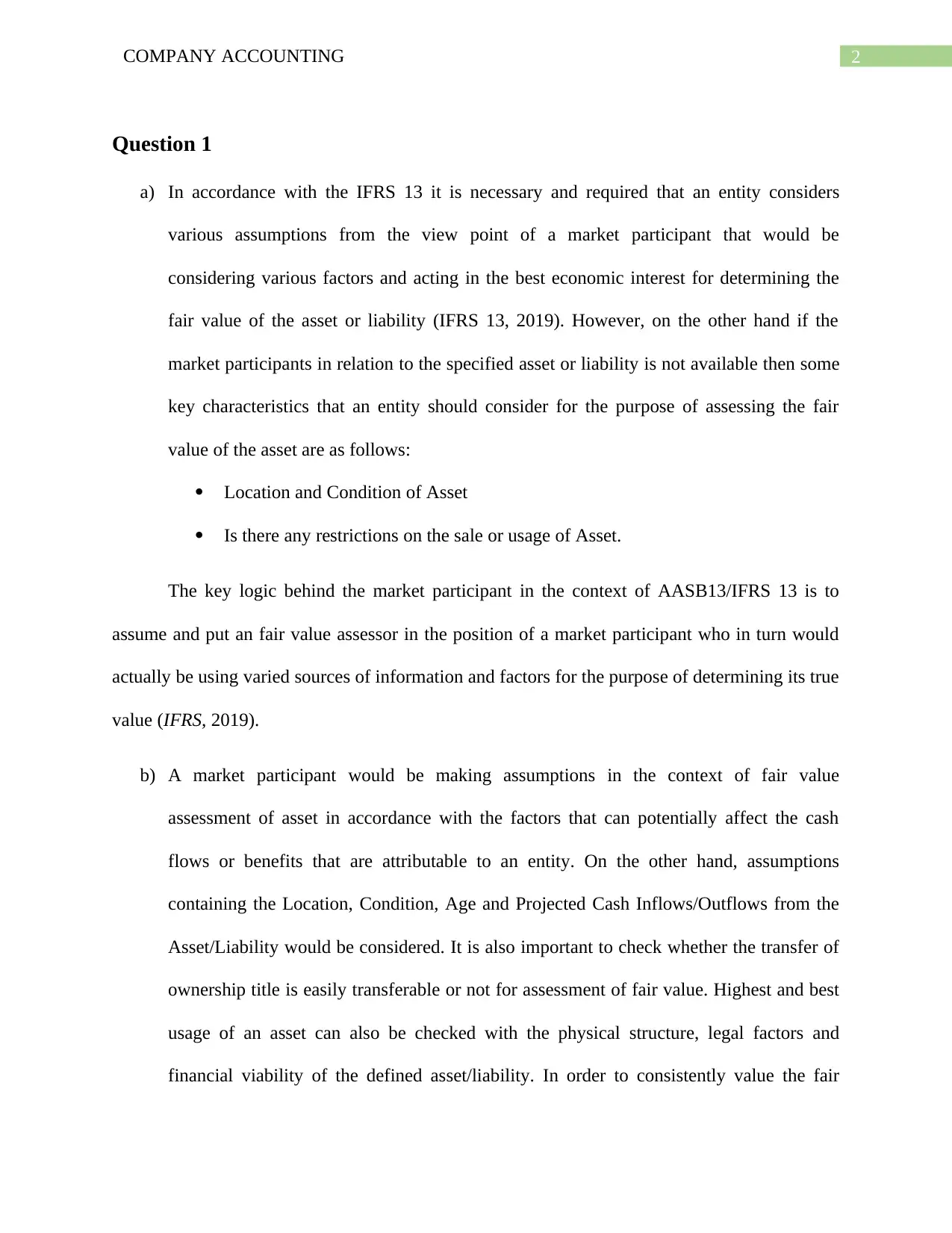
2COMPANY ACCOUNTING
Question 1
a) In accordance with the IFRS 13 it is necessary and required that an entity considers
various assumptions from the view point of a market participant that would be
considering various factors and acting in the best economic interest for determining the
fair value of the asset or liability (IFRS 13, 2019). However, on the other hand if the
market participants in relation to the specified asset or liability is not available then some
key characteristics that an entity should consider for the purpose of assessing the fair
value of the asset are as follows:
Location and Condition of Asset
Is there any restrictions on the sale or usage of Asset.
The key logic behind the market participant in the context of AASB13/IFRS 13 is to
assume and put an fair value assessor in the position of a market participant who in turn would
actually be using varied sources of information and factors for the purpose of determining its true
value (IFRS, 2019).
b) A market participant would be making assumptions in the context of fair value
assessment of asset in accordance with the factors that can potentially affect the cash
flows or benefits that are attributable to an entity. On the other hand, assumptions
containing the Location, Condition, Age and Projected Cash Inflows/Outflows from the
Asset/Liability would be considered. It is also important to check whether the transfer of
ownership title is easily transferable or not for assessment of fair value. Highest and best
usage of an asset can also be checked with the physical structure, legal factors and
financial viability of the defined asset/liability. In order to consistently value the fair
Question 1
a) In accordance with the IFRS 13 it is necessary and required that an entity considers
various assumptions from the view point of a market participant that would be
considering various factors and acting in the best economic interest for determining the
fair value of the asset or liability (IFRS 13, 2019). However, on the other hand if the
market participants in relation to the specified asset or liability is not available then some
key characteristics that an entity should consider for the purpose of assessing the fair
value of the asset are as follows:
Location and Condition of Asset
Is there any restrictions on the sale or usage of Asset.
The key logic behind the market participant in the context of AASB13/IFRS 13 is to
assume and put an fair value assessor in the position of a market participant who in turn would
actually be using varied sources of information and factors for the purpose of determining its true
value (IFRS, 2019).
b) A market participant would be making assumptions in the context of fair value
assessment of asset in accordance with the factors that can potentially affect the cash
flows or benefits that are attributable to an entity. On the other hand, assumptions
containing the Location, Condition, Age and Projected Cash Inflows/Outflows from the
Asset/Liability would be considered. It is also important to check whether the transfer of
ownership title is easily transferable or not for assessment of fair value. Highest and best
usage of an asset can also be checked with the physical structure, legal factors and
financial viability of the defined asset/liability. In order to consistently value the fair
⊘ This is a preview!⊘
Do you want full access?
Subscribe today to unlock all pages.

Trusted by 1+ million students worldwide
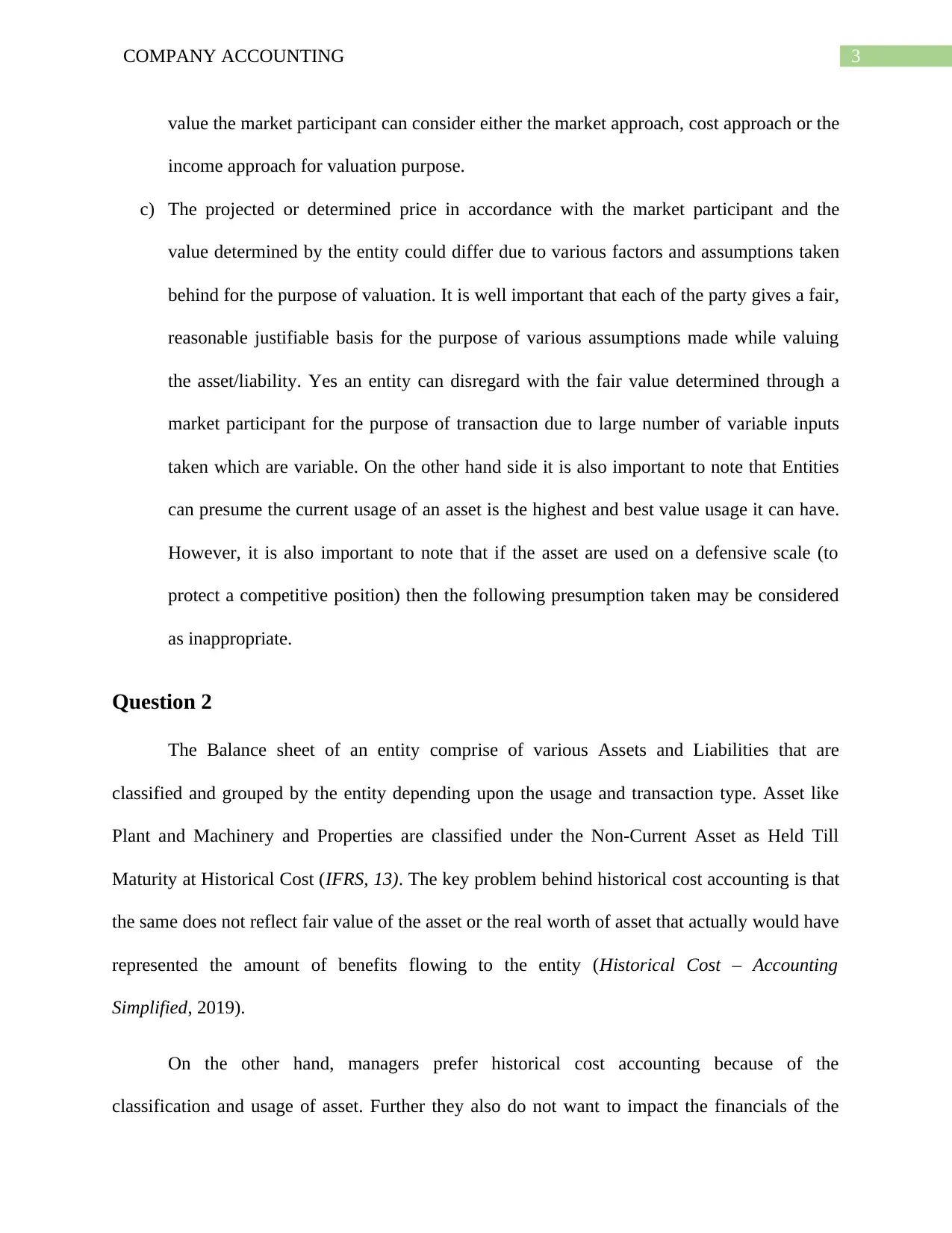
3COMPANY ACCOUNTING
value the market participant can consider either the market approach, cost approach or the
income approach for valuation purpose.
c) The projected or determined price in accordance with the market participant and the
value determined by the entity could differ due to various factors and assumptions taken
behind for the purpose of valuation. It is well important that each of the party gives a fair,
reasonable justifiable basis for the purpose of various assumptions made while valuing
the asset/liability. Yes an entity can disregard with the fair value determined through a
market participant for the purpose of transaction due to large number of variable inputs
taken which are variable. On the other hand side it is also important to note that Entities
can presume the current usage of an asset is the highest and best value usage it can have.
However, it is also important to note that if the asset are used on a defensive scale (to
protect a competitive position) then the following presumption taken may be considered
as inappropriate.
Question 2
The Balance sheet of an entity comprise of various Assets and Liabilities that are
classified and grouped by the entity depending upon the usage and transaction type. Asset like
Plant and Machinery and Properties are classified under the Non-Current Asset as Held Till
Maturity at Historical Cost (IFRS, 13). The key problem behind historical cost accounting is that
the same does not reflect fair value of the asset or the real worth of asset that actually would have
represented the amount of benefits flowing to the entity (Historical Cost – Accounting
Simplified, 2019).
On the other hand, managers prefer historical cost accounting because of the
classification and usage of asset. Further they also do not want to impact the financials of the
value the market participant can consider either the market approach, cost approach or the
income approach for valuation purpose.
c) The projected or determined price in accordance with the market participant and the
value determined by the entity could differ due to various factors and assumptions taken
behind for the purpose of valuation. It is well important that each of the party gives a fair,
reasonable justifiable basis for the purpose of various assumptions made while valuing
the asset/liability. Yes an entity can disregard with the fair value determined through a
market participant for the purpose of transaction due to large number of variable inputs
taken which are variable. On the other hand side it is also important to note that Entities
can presume the current usage of an asset is the highest and best value usage it can have.
However, it is also important to note that if the asset are used on a defensive scale (to
protect a competitive position) then the following presumption taken may be considered
as inappropriate.
Question 2
The Balance sheet of an entity comprise of various Assets and Liabilities that are
classified and grouped by the entity depending upon the usage and transaction type. Asset like
Plant and Machinery and Properties are classified under the Non-Current Asset as Held Till
Maturity at Historical Cost (IFRS, 13). The key problem behind historical cost accounting is that
the same does not reflect fair value of the asset or the real worth of asset that actually would have
represented the amount of benefits flowing to the entity (Historical Cost – Accounting
Simplified, 2019).
On the other hand, managers prefer historical cost accounting because of the
classification and usage of asset. Further they also do not want to impact the financials of the
Paraphrase This Document
Need a fresh take? Get an instant paraphrase of this document with our AI Paraphraser
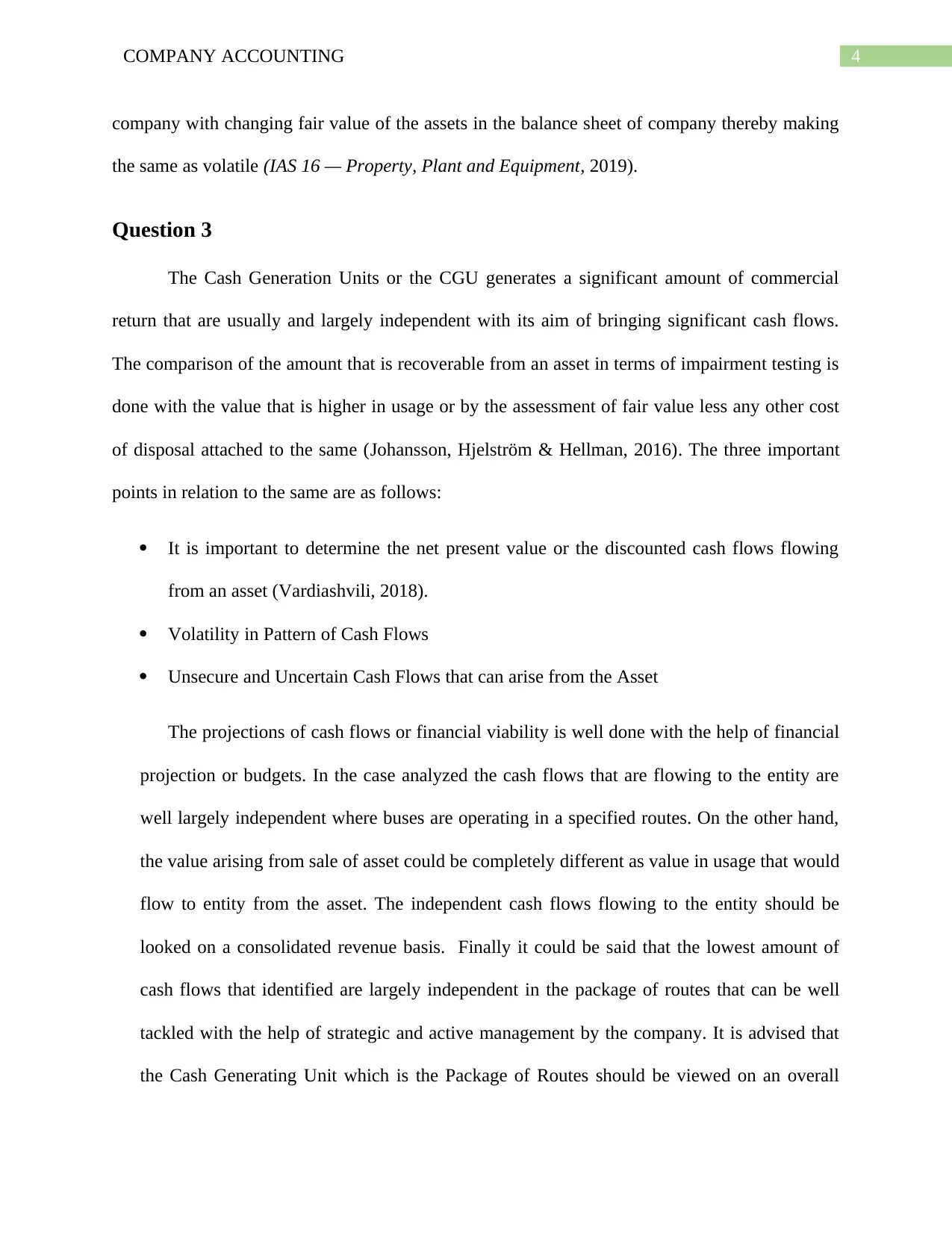
4COMPANY ACCOUNTING
company with changing fair value of the assets in the balance sheet of company thereby making
the same as volatile (IAS 16 — Property, Plant and Equipment, 2019).
Question 3
The Cash Generation Units or the CGU generates a significant amount of commercial
return that are usually and largely independent with its aim of bringing significant cash flows.
The comparison of the amount that is recoverable from an asset in terms of impairment testing is
done with the value that is higher in usage or by the assessment of fair value less any other cost
of disposal attached to the same (Johansson, Hjelström & Hellman, 2016). The three important
points in relation to the same are as follows:
It is important to determine the net present value or the discounted cash flows flowing
from an asset (Vardiashvili, 2018).
Volatility in Pattern of Cash Flows
Unsecure and Uncertain Cash Flows that can arise from the Asset
The projections of cash flows or financial viability is well done with the help of financial
projection or budgets. In the case analyzed the cash flows that are flowing to the entity are
well largely independent where buses are operating in a specified routes. On the other hand,
the value arising from sale of asset could be completely different as value in usage that would
flow to entity from the asset. The independent cash flows flowing to the entity should be
looked on a consolidated revenue basis. Finally it could be said that the lowest amount of
cash flows that identified are largely independent in the package of routes that can be well
tackled with the help of strategic and active management by the company. It is advised that
the Cash Generating Unit which is the Package of Routes should be viewed on an overall
company with changing fair value of the assets in the balance sheet of company thereby making
the same as volatile (IAS 16 — Property, Plant and Equipment, 2019).
Question 3
The Cash Generation Units or the CGU generates a significant amount of commercial
return that are usually and largely independent with its aim of bringing significant cash flows.
The comparison of the amount that is recoverable from an asset in terms of impairment testing is
done with the value that is higher in usage or by the assessment of fair value less any other cost
of disposal attached to the same (Johansson, Hjelström & Hellman, 2016). The three important
points in relation to the same are as follows:
It is important to determine the net present value or the discounted cash flows flowing
from an asset (Vardiashvili, 2018).
Volatility in Pattern of Cash Flows
Unsecure and Uncertain Cash Flows that can arise from the Asset
The projections of cash flows or financial viability is well done with the help of financial
projection or budgets. In the case analyzed the cash flows that are flowing to the entity are
well largely independent where buses are operating in a specified routes. On the other hand,
the value arising from sale of asset could be completely different as value in usage that would
flow to entity from the asset. The independent cash flows flowing to the entity should be
looked on a consolidated revenue basis. Finally it could be said that the lowest amount of
cash flows that identified are largely independent in the package of routes that can be well
tackled with the help of strategic and active management by the company. It is advised that
the Cash Generating Unit which is the Package of Routes should be viewed on an overall
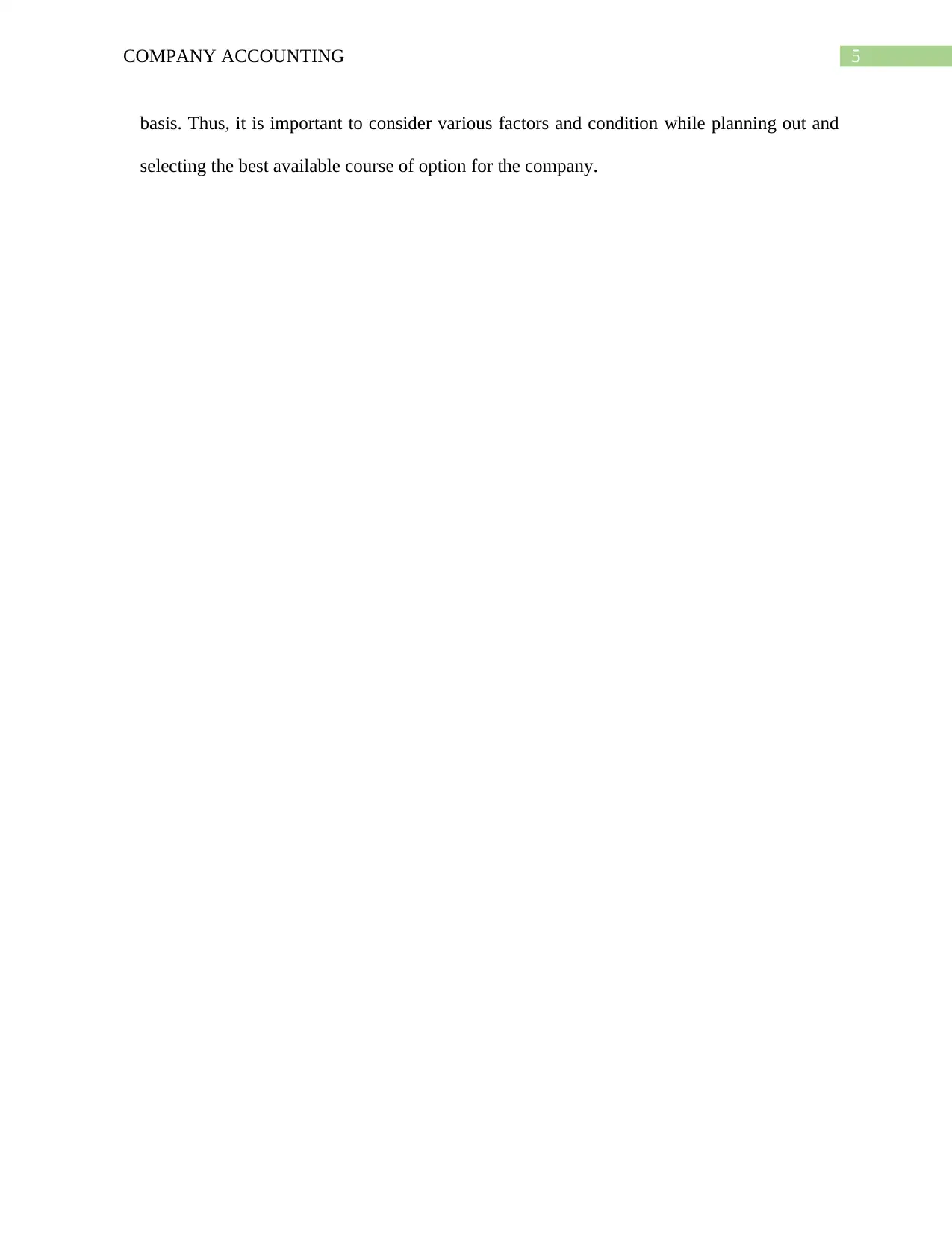
5COMPANY ACCOUNTING
basis. Thus, it is important to consider various factors and condition while planning out and
selecting the best available course of option for the company.
basis. Thus, it is important to consider various factors and condition while planning out and
selecting the best available course of option for the company.
⊘ This is a preview!⊘
Do you want full access?
Subscribe today to unlock all pages.

Trusted by 1+ million students worldwide
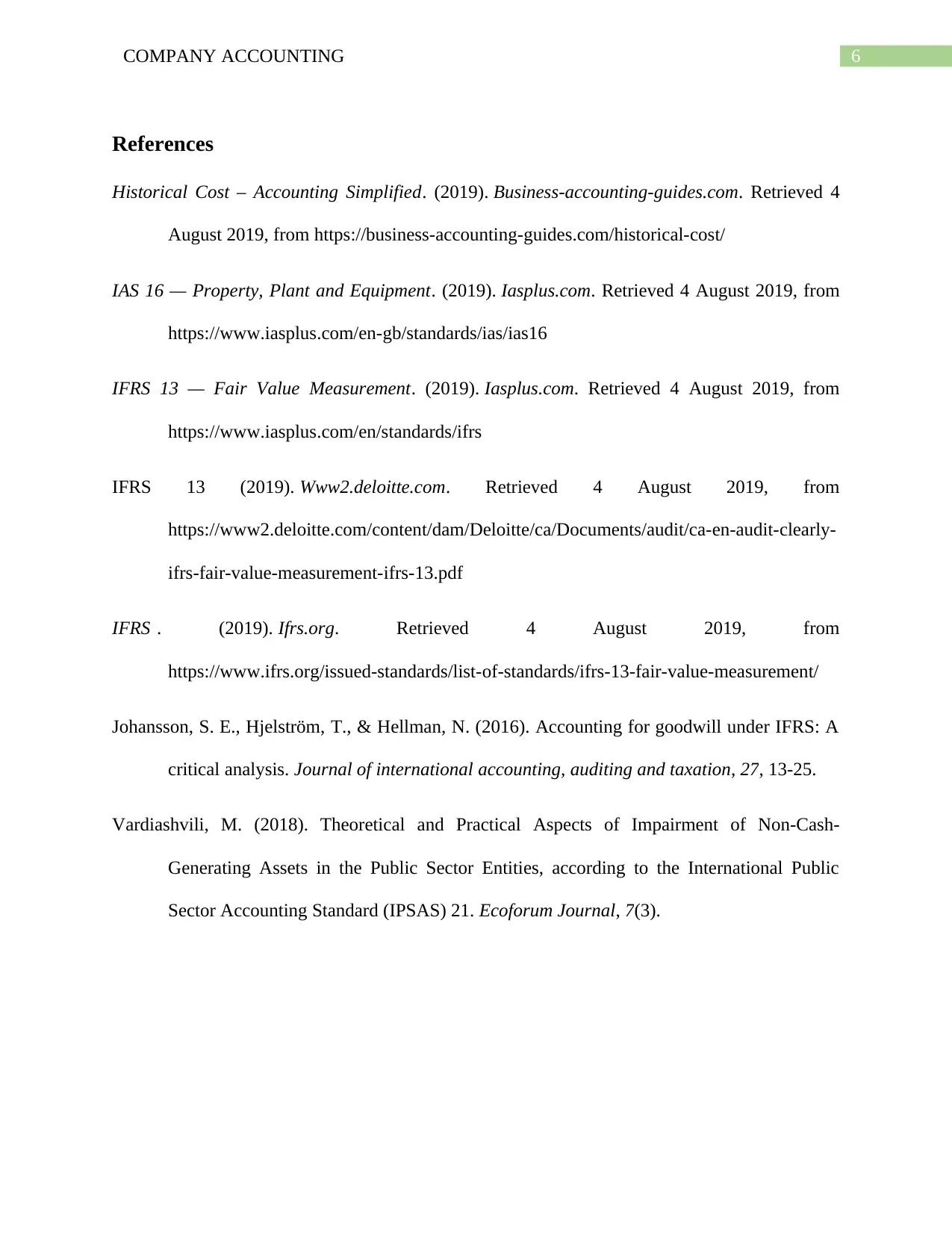
6COMPANY ACCOUNTING
References
Historical Cost – Accounting Simplified. (2019). Business-accounting-guides.com. Retrieved 4
August 2019, from https://business-accounting-guides.com/historical-cost/
IAS 16 — Property, Plant and Equipment. (2019). Iasplus.com. Retrieved 4 August 2019, from
https://www.iasplus.com/en-gb/standards/ias/ias16
IFRS 13 — Fair Value Measurement. (2019). Iasplus.com. Retrieved 4 August 2019, from
https://www.iasplus.com/en/standards/ifrs
IFRS 13 (2019). Www2.deloitte.com. Retrieved 4 August 2019, from
https://www2.deloitte.com/content/dam/Deloitte/ca/Documents/audit/ca-en-audit-clearly-
ifrs-fair-value-measurement-ifrs-13.pdf
IFRS . (2019). Ifrs.org. Retrieved 4 August 2019, from
https://www.ifrs.org/issued-standards/list-of-standards/ifrs-13-fair-value-measurement/
Johansson, S. E., Hjelström, T., & Hellman, N. (2016). Accounting for goodwill under IFRS: A
critical analysis. Journal of international accounting, auditing and taxation, 27, 13-25.
Vardiashvili, M. (2018). Theoretical and Practical Aspects of Impairment of Non-Cash-
Generating Assets in the Public Sector Entities, according to the International Public
Sector Accounting Standard (IPSAS) 21. Ecoforum Journal, 7(3).
References
Historical Cost – Accounting Simplified. (2019). Business-accounting-guides.com. Retrieved 4
August 2019, from https://business-accounting-guides.com/historical-cost/
IAS 16 — Property, Plant and Equipment. (2019). Iasplus.com. Retrieved 4 August 2019, from
https://www.iasplus.com/en-gb/standards/ias/ias16
IFRS 13 — Fair Value Measurement. (2019). Iasplus.com. Retrieved 4 August 2019, from
https://www.iasplus.com/en/standards/ifrs
IFRS 13 (2019). Www2.deloitte.com. Retrieved 4 August 2019, from
https://www2.deloitte.com/content/dam/Deloitte/ca/Documents/audit/ca-en-audit-clearly-
ifrs-fair-value-measurement-ifrs-13.pdf
IFRS . (2019). Ifrs.org. Retrieved 4 August 2019, from
https://www.ifrs.org/issued-standards/list-of-standards/ifrs-13-fair-value-measurement/
Johansson, S. E., Hjelström, T., & Hellman, N. (2016). Accounting for goodwill under IFRS: A
critical analysis. Journal of international accounting, auditing and taxation, 27, 13-25.
Vardiashvili, M. (2018). Theoretical and Practical Aspects of Impairment of Non-Cash-
Generating Assets in the Public Sector Entities, according to the International Public
Sector Accounting Standard (IPSAS) 21. Ecoforum Journal, 7(3).
1 out of 7
Related Documents
Your All-in-One AI-Powered Toolkit for Academic Success.
+13062052269
info@desklib.com
Available 24*7 on WhatsApp / Email
![[object Object]](/_next/static/media/star-bottom.7253800d.svg)
Unlock your academic potential
Copyright © 2020–2025 A2Z Services. All Rights Reserved. Developed and managed by ZUCOL.





